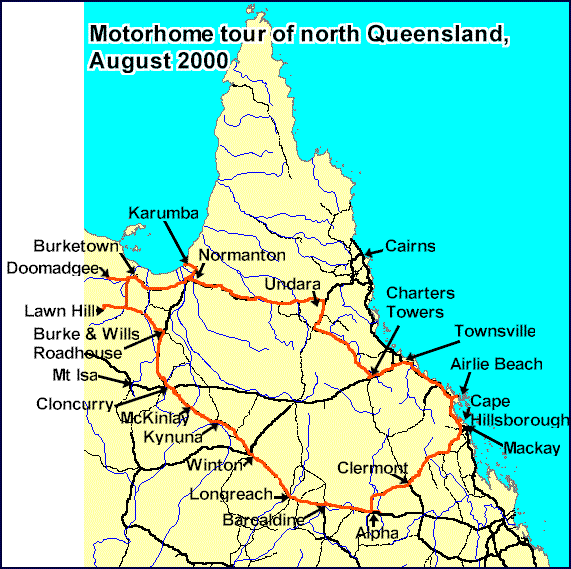Places visited in this part of the trip:
Burketown
Normanton
Karumba
Croydon and Georgetown
Mt Surprise
Undara
Charters Towers
Some general observations
Part 1 took us from Airlie Beach to Longreach, part 2 from Longreach to Doomadgee.
Now we’re heading into the last part of the trip, east across the Gulf of Carpentaria, then towards Cairns (but not as far as the east coast), then south through Charters Towers and home again.
Burketown
Eventually we headed east to Burketown, where we checked out the pub and had some lemon squash. The cafe across the road was closed, so we bought some very overpriced sandwich makings at the store and ate in the very nice park just up the road. The town does have acommodation and a caravan park. For the Tourist information Centre, phone (07) 45455111 http://www.burkeshirecouncil.com/
We could have taken a scenic flight over the Gulf of Carpentaria and the Gulf Savannah country with Savannah Aviation, based in Burketown. They also do fishing trips. Phone 1800 455 445, fax 07 4745 5211, http://savannah-aviation.com/
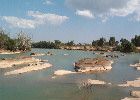 East of Burketown the road gets worse. We went off the road to check out the camping sites at Leichhardt Falls, but the sand and the presence of several caravans (and some large crocodiles sunbathing on a sandbar in the river) didn’t inspire a stay. No facilities there, and the crocodiles meant no swimming. The river crossing was exciting as the causeway was very little wider than the truck.
East of Burketown the road gets worse. We went off the road to check out the camping sites at Leichhardt Falls, but the sand and the presence of several caravans (and some large crocodiles sunbathing on a sandbar in the river) didn’t inspire a stay. No facilities there, and the crocodiles meant no swimming. The river crossing was exciting as the causeway was very little wider than the truck.
Shortly afterwards we crossed the Alexandria River, on the very rough (rocky) natural riverbed. Then on for many kilometres of rough road, through relatively boring gulf savannah country.
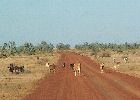
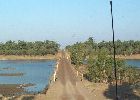
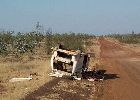 The last 30km before the Normanton turnoff were very corrugated, so we were very happy to get back on the bitumen a few km south of Normanton (this is the direct route from the Burke and Wills roadhouse).
The last 30km before the Normanton turnoff were very corrugated, so we were very happy to get back on the bitumen a few km south of Normanton (this is the direct route from the Burke and Wills roadhouse).
Normanton
When we pulled up at the council caravan park, we discovered that we had a broken stainless steel water tank, presumably caused by being bounced around for many kilometres. Fortunately we had two tanks and could close the connection between them. Also fortunately we were not heading into country where we needed a lot of water onboard.
We stayed at the nicely set up caravan park in the middle of town, which provided good facilities. For dinner, we decided the very visible Purple Pub wasn’t us, but we had been advised to try the Central Hotel. The food (in the private dining room in back) was delicious and plentiful. We had barramundi, our favorite fish, as we were in the heart of barra country.

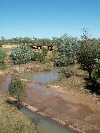 One of Normanton’s major attractions is the Gulflander train trip. We didn’t want to take the full trip to Croydon (about 94 miles), stay overnight, and ride back, although it sounded very interesting (they deliver the mail to stations along the way), so we were pleased that the next day’s trip was a short one, just 16 miles to Critter’s Camp and back. We enjoyed the trip thoroughly, although it was quite bumpy.
One of Normanton’s major attractions is the Gulflander train trip. We didn’t want to take the full trip to Croydon (about 94 miles), stay overnight, and ride back, although it sounded very interesting (they deliver the mail to stations along the way), so we were pleased that the next day’s trip was a short one, just 16 miles to Critter’s Camp and back. We enjoyed the trip thoroughly, although it was quite bumpy.
 One attraction in town in Krys, a full size model of a 28-foot 4-inch saltware crocodile with a girth of 13 feet. The real croc had been shot by crocodile hunter Krystina Pawloski in the Norman River in July 1958.
One attraction in town in Krys, a full size model of a 28-foot 4-inch saltware crocodile with a girth of 13 feet. The real croc had been shot by crocodile hunter Krystina Pawloski in the Norman River in July 1958.
More about Normanton from the Savannah Guides.
Karumba
From Normanton, we travelled the good bitumen road 70 km to Karumba Point, on the sea overlooking the Gulf of Carpentaria. This is the centre of the prawning industry, and nearby is the shipping terminal for the zinc from the Pasminco Century mine. The big tourist attraction is fishing, and there are several charter boats available.
The caravan parks were crowded and looked difficult to get our truck into, so we booked into a motel unit (called Gone Fishin’) across the street from the Sunset Tavern for two days. Ash’s units probably had better facilities, but we wanted to be able to park the motorhome in front of the room. We can however praise highly the $4.40 barra from Ash, which we had for lunch each day.
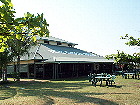

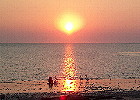 Sunset Tavern, on the point, was the place for the evening. The sea coast is such that you look west and can watch the sun set in a blaze of red across the Gulf of Carpentaria. This was helped by yet another barramundi dinner, and a bottle of wine. As we live on the east coast, we are not used to seeing the sun setting over water, so it was a great treat for us.
Sunset Tavern, on the point, was the place for the evening. The sea coast is such that you look west and can watch the sun set in a blaze of red across the Gulf of Carpentaria. This was helped by yet another barramundi dinner, and a bottle of wine. As we live on the east coast, we are not used to seeing the sun setting over water, so it was a great treat for us.
 Karumba Point is a pleasant spot, and ideal if you’re into fishing, by boat or from shore. A walk along the shore just after dawn revealed dozens of people comfortably set up for a morning’s (or a day’s) fishing. The local pelicans kept an eye on the fishing, and also came along at sunset to inspect the crab traps as they were emptied.
Karumba Point is a pleasant spot, and ideal if you’re into fishing, by boat or from shore. A walk along the shore just after dawn revealed dozens of people comfortably set up for a morning’s (or a day’s) fishing. The local pelicans kept an eye on the fishing, and also came along at sunset to inspect the crab traps as they were emptied.
More about Karumba. Also here.
Croydon and Georgetown
From Karumba we returned to Normantown, then drove to Croydon and on to Georgetown. The map showed some dirt on this stretch, but the road is now paved all the way. We passed the turnoffs for several camping spots, including Shady Lagoons.
We stopped for lunch at Black Bull Siding, 60 km west of Croydon. There is a nice area for camping there, and a few old relics of the railway. No store or food service, but the couple who live there sell soft drinks, and there are showers and toilets.
Founded around 1886, Croydon is now a small historical village of less than 400 people, with several mining museums. Little remains of the large gold mining city it was over a century ago, when the population peaked at 8,000 and there were 26 pubs. It is the eastern terminal of the Gulflander train from Normanton.
In Georgetown, we stayed at the Midway Caravan Park, where we again had problems with trees whose limb height we exceeded. Their little shop sold an amazing variety of goods and services, being a service station, very decent cafe, lottery agent, video shop, pharmacy and photolab—and they had accommodation and a swimming pool.
Georgetown had also been a gold town, and with a fossicking permit you can still search for nuggets; now and then someone finds one. However, the town didn’t seem to offer much else (though there was internet access at the public library). We had dinner at the caravan park and drove on the next day.
More about Croydon from Savannah Guides, http://www.savannah-guides.com.au/page2-2.html
More about Georgetown from the Savannah Guides.
Mt Surprise
Another 100 km of narrow road brought us to Mt Surprise, one of the stations for the Savannahlander train. We didn’t stop at the nearby Tallaroo Hot Springs, but that is said to be a pleasant diversion. Other than the train, there were two service stations and a few small museums, which mostly appeared closed. We got very good service at the hotel, which had showers for travellers. There were several caravan parks in the area, but we continued on our way.
More about Mt Surprise from the Savannah Guides.
Undara
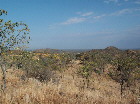 We reached Undara, famous for its lava tubes, just after lunch time, after only 15 km of corrugated dirt road off the main road. The main crater of this system of over 160 craters was formed 190,000 years ago. The lava flowed through the mostly flat terrain and along old river beds. The surface solidified while lava continued to flow. The flow was such that many of the tubes emptied themselves of lava when the flow ended, leaving huge hollowed-out lava tubes. The longest tube was 160 km long.
We reached Undara, famous for its lava tubes, just after lunch time, after only 15 km of corrugated dirt road off the main road. The main crater of this system of over 160 craters was formed 190,000 years ago. The lava flowed through the mostly flat terrain and along old river beds. The surface solidified while lava continued to flow. The flow was such that many of the tubes emptied themselves of lava when the flow ended, leaving huge hollowed-out lava tubes. The longest tube was 160 km long.
http://www.undara.com.au/
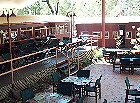
 We dined at the Undara Lava Lodge, which had a nice barbeque with all-you-can-eat salads to go with beef, pork, lamb, chicken, crocodile or kangaroo steaks. Much of the lodge is contructed from renovated railway carriages, including the accommodation units and the restaurant and bar. Permanent tents are also available, as well as space for caravans, motorhomes, and tent camping. It’s advisable to book in advance during the winter season, because the accommodation and camping area can be completely full. At the time we visited (early September), the campground was almost empty. We’re not sure why everyone gave up earlier than usual in the season, but the guides speculated that a minor heat wave on the nearby coast made everyone think the interior would be scorching. In fact, it was quite pleasant.
We dined at the Undara Lava Lodge, which had a nice barbeque with all-you-can-eat salads to go with beef, pork, lamb, chicken, crocodile or kangaroo steaks. Much of the lodge is contructed from renovated railway carriages, including the accommodation units and the restaurant and bar. Permanent tents are also available, as well as space for caravans, motorhomes, and tent camping. It’s advisable to book in advance during the winter season, because the accommodation and camping area can be completely full. At the time we visited (early September), the campground was almost empty. We’re not sure why everyone gave up earlier than usual in the season, but the guides speculated that a minor heat wave on the nearby coast made everyone think the interior would be scorching. In fact, it was quite pleasant.
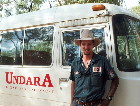
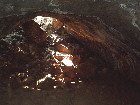 Thomas Atkinson, grandson of the geologist who wrote up some of the details of the tubes, took us on both the morning and afternoon tours and told us a lot about the history and geology of the area. We were the only people on the afternoon tour. In addition to the lava tubes, we saw lots of wallaroos, some emus, cave cockroaches and bats. Some of the mineral patterns on the walls and ceilings of the tubes were really striking.
Thomas Atkinson, grandson of the geologist who wrote up some of the details of the tubes, took us on both the morning and afternoon tours and told us a lot about the history and geology of the area. We were the only people on the afternoon tour. In addition to the lava tubes, we saw lots of wallaroos, some emus, cave cockroaches and bats. Some of the mineral patterns on the walls and ceilings of the tubes were really striking.
Thomas also told us about the Savannah Guides, a network of professional tour guides first established in 1998, and now spreading around northwest Queensland. Their local knowledge is checked by their peers before they are accredited. Tours with their logo tend to offer an informed and interesting guide. http://www.savannah-guides.com.au/
We took an extra rest day at Undara, which was such a pleasant place that we considered staying longer. However, we were now within two days’ drive from home, and wanted to get there, so we went on.
More about Undara from Savannah Guides, http://www.savannah-guides.com.au/page3-1.html
Charters Towers
Up early, and off along the long mostly empty road to Charters Towers. After passing Lynd Junction, we came upon a very tidy former mining town called Greenvale. The Three Rivers Hotel had a great collection of hubcap clocks on the walls. They were trying to make up a museum for crossword puzzles, and had some really great ones on display. We lunched at the pub, across from the supermarket.
On to Bluewater Springs for another cooling drink. We spotted some nice looking bush camping sites by running water about 50 km short of Charters Towers, but pressed on and finally reached Charters Towers, where we stayed at the Dalrymple Caravan Park because there was room to get the truck in, although it was 2 km from town. We checked the Mexican Caravan Park, the one closest to the town centre (and named for the old gold mine), but there was no way our motorhome would fit into this small crowded park.
For the first time since Longreach, the GSM phone could pick up a signal. We were now officially back in civilisation!
Wanting to get home, we did no sightseeing in Charters Towers this trip, but drove on the next day. About 76 km along the road to Townsville we came across a rather nice little 48 hour rest area with toilets and BBQs but no showers or drinking water, near Red River. We always seemed to find these places when we didn’t need them.
We took the back road from Woodstock to the Bruce Highway, bypassing Townsville, a city we visit often. This was a rough ride for a bitumen road. Once on the Bruce Highway, we found that we really did slow down traffic, but fortunately there weren’t a lot of people to be inconvenienced. We got home by early afternoon.
Some general observations
The roads were mostly better than we expected, although a few were in very rough condition. Except for parts of the Gulf Savannah country, we could have done the whole trip in a conventional (non-4WD) vehicle. The road from Cloncurry to Normanton is paved all the way (though only one lane), so we could have had a good taste even of the Gulf country.
More places than we expected had hotel or motel rooms, although many of those were of the shared-facilities variety, and could easily be taken, especially if a tour group came through. But you could bring a tent to use if needed, and stay in motel rooms most of the time if you wanted to.
Public pay phones are readily available, but few accommodation units have phones in the rooms. Internet access is commonly available, though often at restricted times, but finding some place to connect one’s own computer to the phone lines is generally not easy. Mobile (cellular) phone access is almost non-existent away from major towns.
Food was plentiful and mostly good to great in the pubs and roadhouses along the way. We only cooked dinner once the whole trip, preferring to let someone else do the work.
In all, the trip we took was considerably less rugged than it would have been 20 years ago, though parts of it would still be difficult if not impossible in wet weather. Of course, there were many places we could have gone off the main roads, where we would have needed the 4WD, but we didn’t have good enough maps or the necessary experience in off-road driving, so we didn’t go to those places. Perhaps another year?
We had nearly perfect weather for the trip, but you can’t count on that. It wasn’t too hot, or too cold, or too humid; very little rain fell (a problem for the farmers, but nice for us); and no windstorms occurred. However, we did drive too far in the 4-1/2 weeks, and we didn’t spend enough time just being lazy and enjoying the experience.
We also didn’t do enough bush camping, preferring to have electricity and the use of someone else’s shower and toilet. Our motorhome is self-contained, but it’s a bit cramped. The solar power system and batteries would give us enough power for several days’ use, even with my computer on for several hours a day, but we didn’t push it.
General introduction to the Gulf Savannah and the Savannah Way. Also on the Savannah Guides website.

